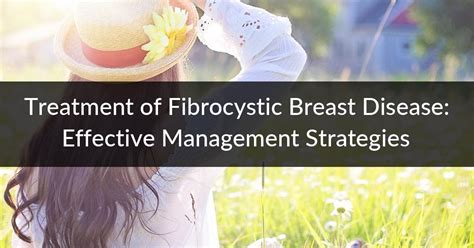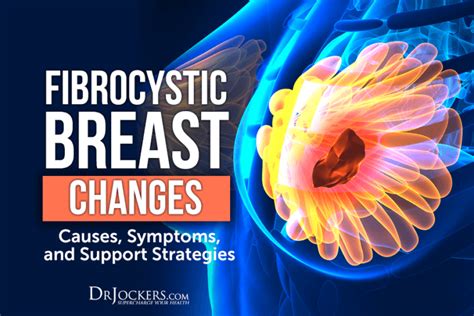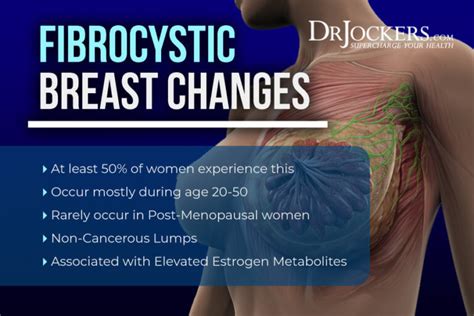Intro
Discover 5 effective fibrocystic treatments, including natural remedies and medical options, to alleviate breast tenderness, cysts, and lumps, and learn about fibrocystic breast disease management and prevention techniques.
Fibrocystic breast disease, also known as fibrocystic breast changes, is a condition characterized by the development of lumps or cysts in the breast tissue. This condition is extremely common, affecting up to 60% of women at some point in their lives. While it is not typically a cause for concern, fibrocystic breast disease can cause discomfort, pain, and anxiety for those who experience it. Fortunately, there are various treatments available to help manage the symptoms of fibrocystic breast disease.
The symptoms of fibrocystic breast disease can vary from woman to woman, but common complaints include breast tenderness, lumps or cysts, and changes in breast texture. These symptoms can be exacerbated by hormonal fluctuations, particularly during the menstrual cycle. In some cases, women may experience discharge or nipple tenderness, although these symptoms are less common. Understanding the symptoms and causes of fibrocystic breast disease is essential for developing effective treatment strategies.
For women living with fibrocystic breast disease, finding effective treatments can be a game-changer. From lifestyle modifications to medical interventions, there are numerous options available to help alleviate symptoms and improve quality of life. In this article, we will explore five fibrocystic treatments that have shown promise in managing the condition. Whether you are seeking relief from breast tenderness or looking to reduce the frequency of cysts, these treatments may offer the solution you have been searching for.
Fibrocystic Treatment Overview

When it comes to treating fibrocystic breast disease, a comprehensive approach is often the most effective. This may involve a combination of lifestyle modifications, dietary changes, and medical interventions. By addressing the underlying causes of the condition and managing symptoms, women can reduce their discomfort and improve their overall well-being. Some of the key factors to consider when developing a treatment plan include hormonal balance, breast health, and overall lifestyle.
Importance of Hormonal Balance
Hormonal fluctuations play a significant role in the development and exacerbation of fibrocystic breast disease. The hormones estrogen and progesterone, in particular, can contribute to the growth of cysts and the tenderness associated with the condition. By maintaining hormonal balance, women can reduce their symptoms and improve their breast health. This may involve dietary changes, stress management, and other lifestyle modifications.Lifestyle Modifications for Fibrocystic Breast Disease

Lifestyle modifications are often the first line of defense against fibrocystic breast disease. These changes can help reduce symptoms, improve breast health, and enhance overall well-being. Some of the most effective lifestyle modifications for fibrocystic breast disease include:
- Avoiding caffeine and other stimulants, which can exacerbate symptoms
- Maintaining a healthy weight, which can reduce the risk of developing cysts
- Engaging in regular exercise, which can improve hormonal balance and reduce stress
- Practicing stress management techniques, such as meditation or yoga, to reduce anxiety and promote relaxation
- Getting enough sleep, which is essential for hormonal balance and overall health
Dietary Changes for Fibrocystic Breast Disease
Dietary changes can also play a crucial role in managing fibrocystic breast disease. A diet rich in fruits, vegetables, and whole grains can help reduce inflammation and promote hormonal balance. Additionally, avoiding foods that can exacerbate symptoms, such as dairy and soy, may be beneficial. Some of the key dietary changes for fibrocystic breast disease include: * Increasing omega-3 fatty acid intake, which can reduce inflammation and promote breast health * Eating foods high in antioxidants, such as berries and leafy greens, to reduce oxidative stress * Avoiding processed and packaged foods, which can contain hormones and other substances that may exacerbate symptomsMedical Interventions for Fibrocystic Breast Disease

In some cases, medical interventions may be necessary to manage the symptoms of fibrocystic breast disease. These interventions can range from over-the-counter pain medications to prescription therapies. Some of the most common medical interventions for fibrocystic breast disease include:
- Over-the-counter pain medications, such as ibuprofen or acetaminophen, to reduce breast tenderness and discomfort
- Hormonal therapies, such as birth control pills, to regulate hormonal balance and reduce symptoms
- Anti-estrogen medications, such as tamoxifen, to reduce the growth of cysts and alleviate symptoms
Alternative Therapies for Fibrocystic Breast Disease
Alternative therapies, such as acupuncture and massage, may also be beneficial in managing the symptoms of fibrocystic breast disease. These therapies can help reduce stress, promote relaxation, and improve overall well-being. Some of the most effective alternative therapies for fibrocystic breast disease include: * Acupuncture, which can help reduce pain and inflammation * Massage, which can promote relaxation and reduce stress * Aromatherapy, which can help reduce anxiety and promote relaxationNatural Remedies for Fibrocystic Breast Disease

Natural remedies can also play a crucial role in managing the symptoms of fibrocystic breast disease. These remedies can range from herbal supplements to topical treatments. Some of the most effective natural remedies for fibrocystic breast disease include:
- Evening primrose oil, which can help reduce inflammation and promote hormonal balance
- Flaxseed, which can help reduce the growth of cysts and alleviate symptoms
- Vitamin E, which can help reduce oxidative stress and promote breast health
Topical Treatments for Fibrocystic Breast Disease
Topical treatments, such as warm compresses and castor oil packs, can also be beneficial in managing the symptoms of fibrocystic breast disease. These treatments can help reduce pain and inflammation, promote relaxation, and improve overall well-being. Some of the most effective topical treatments for fibrocystic breast disease include: * Warm compresses, which can help reduce pain and inflammation * Castor oil packs, which can help reduce the growth of cysts and alleviate symptoms * Breast massage, which can help promote relaxation and reduce stressConclusion and Next Steps

Fibrocystic breast disease can be a challenging and uncomfortable condition to manage, but there are numerous treatments available to help alleviate symptoms and improve quality of life. By understanding the causes and symptoms of the condition, women can develop effective treatment strategies that address their unique needs. Whether you are seeking relief from breast tenderness or looking to reduce the frequency of cysts, there are options available to help you manage your symptoms and improve your overall well-being.
We invite you to share your thoughts and experiences with fibrocystic breast disease in the comments below. Have you found any treatments or remedies to be particularly effective in managing your symptoms? Do you have any questions or concerns about the condition or its treatment? By sharing your insights and engaging with others, we can work together to create a supportive and informative community for women living with fibrocystic breast disease.
What are the common symptoms of fibrocystic breast disease?
+The common symptoms of fibrocystic breast disease include breast tenderness, lumps or cysts, and changes in breast texture. These symptoms can be exacerbated by hormonal fluctuations, particularly during the menstrual cycle.
How can I manage the symptoms of fibrocystic breast disease?
+There are several ways to manage the symptoms of fibrocystic breast disease, including lifestyle modifications, dietary changes, and medical interventions. Some of the most effective strategies include avoiding caffeine and other stimulants, maintaining a healthy weight, and engaging in regular exercise.
Are there any natural remedies for fibrocystic breast disease?
+Yes, there are several natural remedies that may be beneficial in managing the symptoms of fibrocystic breast disease. These include evening primrose oil, flaxseed, and vitamin E. Additionally, topical treatments such as warm compresses and castor oil packs may also be effective.
